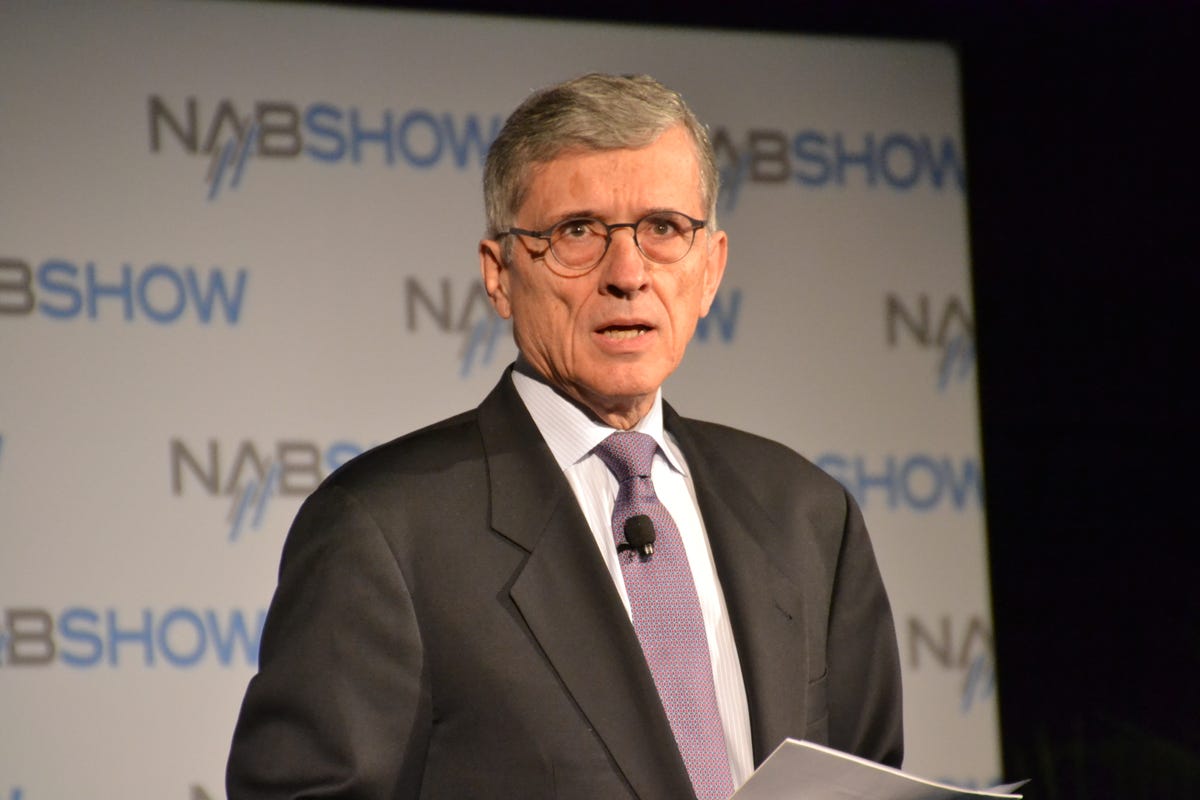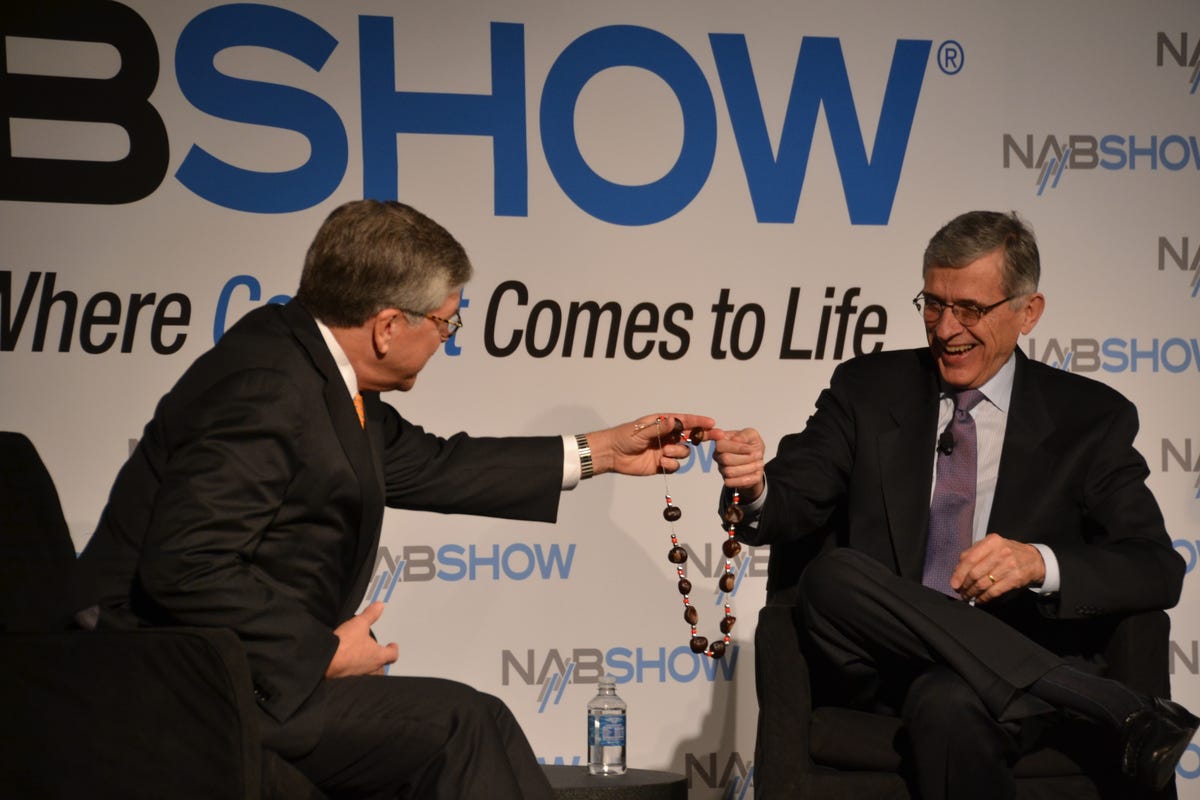
CNET/Marguerite Reardon
LAS VEGAS — Federal Communications Chairman Tom Wheeler has a plan to save the broadcasting industry, he said during a speech Wednesday at the National Association of Broadcasters meeting here. But it may not be the solution broadcasters were hoping for.
Wheeler — whose appearance at the convention was highly anticipated because of ongoing tensions over newly imposed FCC rules and the upcoming spectrum auction — outlined a plan for broadcasters that he said would save their industry from extinction. The main message was that broadcasters need to change with the times. And if they don’t, they’ll likely go the way of the dinosaur.
“We are at an inflection point in history, where broadcast licensees can go from being the disrupted to becoming the disruptor,” he said.
He sympathized with the industry over the hard challenges it faces, but he emphasized that broadcasters need to change to stay alive.
“Nobody likes technological change and the way it restructures business,” he said. “But those who win are those who say, ‘OK, how do I take advantage of this?'”
The cornerstone of his vision for TV broadcasters is for them to take their highly valuable local TV content and deliver it not necessarily over their own airwaves but over the Internet to consumers who want to view it when and where they want. In essence, he said that TV broadcasters could become Netflix-like distributors of local news over both wired and wireless broadband connections. He cited a recent Pew Research report that showed that a third of Americans now watch news online.
“I hope that we can see local broadcast licensees as a growing source of competition in the digital content market,” he said. “Your content represents far more potential than retransmission fees. It can be the basis for fixed and mobile cablelike services.
He added that the upcoming incentive spectrum auction, which will let broadcasters sell all or some of their spectrum licenses back to the government so that they can then be resold to the wireless industry, will help pay for this transition in business strategy. He called the auction a once-in-a-lifetime opportunity for broadcasters to invest in their own businesses “on someone else’s dime.”
Wheeler’s talk comes as broadcasters are increasingly leery of the FCC’s intentions and commitment to preserving the broadcast business. A week ago, the FCC issued new rules that make it more difficult for local TV stations to form advertising sales partnerships. The agency also ended the practice of allowing multiple TV stations to negotiate distribution deals with cable and satellite operators.


CNET/Marguerite Reardon
Wheeler explained that these moves were not attacks on the industry but efforts to ensure the playing field is kept level and that certain players aren’t abusing the FCC’s rules regarding the protection of competition, diversity, and localism. He said the waiver process put in place is designed to ensure that small and minority stations are not inadvertently harmed by the new rules.
Some in the broadcast industry fear the FCC is using these new rules as a way to strong-arm broadcasters into giving up their spectrum in the upcoming incentive spectrum auction. Broadcasters are being asked to voluntarily sell their spectrum back to the government, which will then sell the spectrum to wireless broadband providers. The FCC is still working out the rules for the auction, which is scheduled to take place by mid 2015.
Wheeler defended the agency against allegations that it is coercing broadcasters to give up spectrum.
“There is no conspiracy,” he said. “Those who want to participate in the auction can. And those who don’t, that’s fine.”
But he cautioned broadcasters that there is unlikely to be another opportunity for them to sell their spectrum to the government in this fashion in the future. And he said that if the industry doesn’t transform its business to reflect the new business realities, others will step in to fill the need. Namely, he pointed to Internet giant Yahoo, which is planning a $300 million investment in providing news clips on its site. He said that wireless companies AT&T and Verizon are also looking at using broadcast LTE technology to deliver video. Verizon has already struck a $1 billion deal for NFL content and it recently bought a video distribution platform from Intel.
“Clearly Yahoo, AT&T, and Verizon are aware that history is full of businesses that clung to old models and didn’t survive,” he said. “They’re embracing something new that looks startlingly like your business. We hope that broadcast licensees will see this as a call to action.”
During a question-and-answer period with NAB President and CEO Gordon Smith, Smith pressed Wheeler on the FCC’s willingness to preserve the heart of the broadcasting industry’s business, which is delivering free over-the-air video content to people who otherwise couldn’t afford the cost of expensive services like cable TV and broadband.
“We represent the people who can’t afford to pay for every bit that goes over a broadband network, or who can’t afford their phones and TV service,” Smith said.
Though Wheeler praised broadcasters for their public service and even said he helped his daughter install an antenna at home so she could receive free TV instead of paying a hefty cable TV bill, he stopped short of talking about how broadcasters can use their existing spectrum and broadcast distribution technology to continue to distribute TV to mobile devices.
Instead, he focused on the possibility of broadcasters sharing spectrum with each other in order to free up channels that could be sold to the wireless industry. And he encouraged broadcasters to get involved in the issue of Net neutrality, because ultimately, he said, keeping the Internet open would benefit broadcasters looking to distribute their content via fixed and wireless broadband networks.
But he made no mention of existing broadcast mobile TV efforts. And he lightly touched on the FCC’s willingness to work with the broadcast industry when new standards for distributing broadcast video over the air to mobile devices are established.
Following Wheeler’s talk, NAB Executive Vice President for Strategic Planning Rick Kaplan said that even though broadcasters appreciate the chairman’s efforts to offer up a plan for the future, he was disappointed that Wheeler didn’t see the existing broadcast network as a worthy competitor to the current wireless broadband model, especially for video distribution.
Kaplan, former chief of FCC’s wireless bureau under Chairman Julius Genachowski, said there’s not enough spectrum available for the wireless industry to effectively deliver the demands of live TV events to mobile devices. He said broadcast by nature is the only distribution model that is equipped to handle the load.
“Chairman Wheeler laid out a plan that has broadcasters relying on cable and phone companies to deliver our content,” he said. “But he ignored the benefits of our one-to-many architecture, which is the only way that mass video can be distributed.”
To that end, Wheeler said the FCC wants to work with broadcasters. And when asked by NAB’s Smith about his suggestion of developing a National Broadcast Plan that provides a roadmap for how to preserve the broadcast industry and ready it for the future, Wheeler said he was open to it, so long as Congress approves it and foots the bill.
“I take the suggestion of a National Broadcast Plan seriously,” he said. “If Congress will do the same kind of thing that it did for the National Broadband Plan in terms of granting authority and funding it, I will guarantee, we will deliver a plan.”
He reiterated that the FCC is not working at odds with the broadcast industry.
“I’m not here to rehash old issues,” he said. “We want to work with you to focus on the future. You have an opportunity to think new and act anew. It’s our job to facilitate such innovation.”



